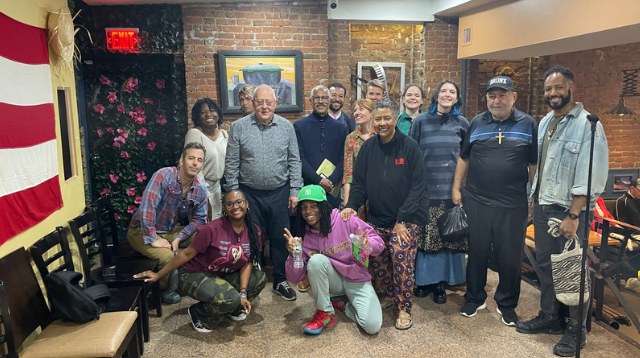5 min read

At Union Theological Seminary, our commitment to fostering a deeper understanding of diverse communities and cultures goes beyond the classroom. Students have the opportunity to embark on remarkable weekend courses that offer a unique blend of education and exploration. Recently, Rev. Dr. Samuel Cruz, a dedicated professor at Union, led an extraordinary course titled “Black and Spanish Harlem,” which delved into the vibrant history and culture of these iconic New York neighborhoods.
In a captivating interview, Dr. Cruz shared his insights into the genesis of the “Black and Spanish Harlem” course. Dr. Cruz’s work at Union includes teaching two courses that were particularly influential: “African Religions in the Americas” and “Methods in the Study of Urban Life and Religion.” It was the latter that provided the initial spark for the extended weekend course.
Dr. Cruz described how he routinely takes his students in the “Methods in the Study of Urban Life and Religion” course on a brief 2-3 hour tour of Black and Spanish Harlem. This tour serves as a gateway to explore the rich culture, religion, art, and music that thrives in these neighborhoods. The limited duration of the tour left both the students and Dr. Cruz seeking more. They sought to delve deeper into the history, and thus, the idea for the extended course came about.
The course’s inspiration goes beyond just an exploration of culture and history; it embodies a call for unity. Dr. Cruz passionately emphasizes the importance of the Black and Latino Coalition, a strong force in New York City. In a world where urban centers are home to a diverse mix of African and Latino populations, it is crucial to build bridges of collaboration instead of fostering competition. Dr. Cruz illustrated the intertwined nature of these communities by sharing fascinating examples from history.
One such example is the Arthur Schomburg Library, a renowned research center for African studies. What many don’t realize is that Arthur Schomburg is, in fact, Arturo Schomberg, a Puerto Rican of African descent. This detail is a testament to the interwoven histories of the Black and Latino communities. Arturo Schomberg’s extensive collection of books on African culture and people of African descent globally reflects his pan-Africanist vision.
In the realm of music, Black and Spanish Harlem played a pivotal role in the development of jazz music, Latin music, and Latin jazz. The course explores the collaboration between Cuban, Puerto Rican, and Black musicians, creating some of the most iconic music known today. The influence of figures like Mario Bauzá, Dizzy Gillespie, Ella Fitzgerald, Duke Ellington, Langston Hughes, and Cicily Tyson permeated these neighborhoods, leaving a lasting legacy.
The course also delves into the intersection of religion and activism. Harlem was a fertile ground for political and religious movements, hosting institutions like the Canaan Baptist Church, which supported Martin Luther King Jr.’s cause immensely. The Young Lords party, a revolutionary movement, was born in Harlem, along with various churches representing diverse faiths, from Baptist to Pentecostal, and mosques and spiritual practices like Santeria, Vodou, Candomblé, and Espiritismo. These neighborhoods exhibit a rich tapestry of interreligious engagement.
One of the course’s highlights was the visit to La Sinagoga, a church named “Synagogue” in English. Dr. Cruz uncovered the historical layers of this church’s name, showcasing how newly arrived immigrants often worship in repurposed spaces, echoing the adaptability of urban environments.
At the Apollo Theater, a legendary venue for budding actors, musicians, and comedians, the students had the honor of being led by Felipe Luciano, the chair and founder of the Young Lords movement. He regaled the group with his poetry, an experience that bridged the past and present.
The journey was about exploring history and confronting contemporary issues, notably gentrification, which threatens to displace historically rich communities. Students witnessed firsthand the gentrification process, where outside investment often seeks to co-opt culture while leaving the residents behind.
Throughout the course, students were encouraged to reflect on their cultural backgrounds and identities concerning the material presented. The aim was to challenge stereotypes and reframe perspectives on Black and Spanish Harlem as vibrant centers of culture, history, and unity.
Dr. Cruz’s course aligns with Union Theological Seminary’s mission of promoting interreligious engagement and encapsulates the institution’s dedication to transcending academic boundaries. It offers a profound opportunity for students to connect classroom learning with the lived realities of the world.
Taking place during Latinx Heritage Month, its diverse composition – including white, Asian, Latino, and Black students – made it particularly relevant. It provided a platform to celebrate the contributions of these communities, emphasizing the importance of recognizing the early advocates for Latino rights within NYC.
“Black and Spanish Harlem” stands as a testament to the power of education and exploration, and the course’s legacy will undoubtedly continue to inspire students at Union Theological Seminary.
